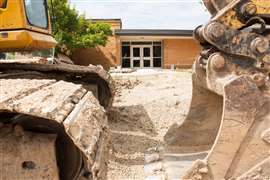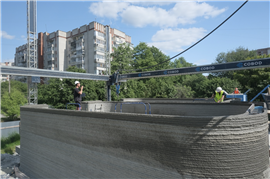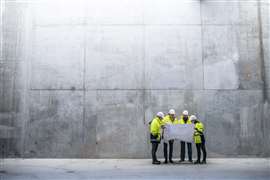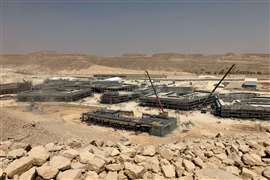Read this article in Français Deutsch Italiano Português Español
3 regions to watch in the education construction sector
28 March 2024
Get out your pencils, erasers, and paper because we’re going back to school.
The school construction sector, that is, as 2024 is shaping up to be one of the busiest years globally for new education builds and education infrastructure modernisation.
 A school construction site. Education builds are popping up across the globe as nations are set to spend billions on school infrastructure. (Image: Adobe Stock)
A school construction site. Education builds are popping up across the globe as nations are set to spend billions on school infrastructure. (Image: Adobe Stock)
While education construction investment can be cyclical based on region, the economy, and government oversight, countries in every continent are earmarking more funds for public instruction than ever before, and a lot of that money will go toward demolition, new building, and expansion.
Here’s a look at three regions that will see increased opportunities for contractors in the education construction sector.
New York City/New Jersey
NYC makes massive education investment
No country spends more total money than the US on education (estimated at more than US$1 trillion annually), and no state in America spends more than New York (estimated near $80 billion). Of course, the state’s largest metropolis – New York City (NYC) – logically spends more than any other US city (estimated near $40 million).
The NYC Department of Education (NYC DOE) and School Construction Association (SCA) proposed an initial five-year capital plan for FY2020-2024, which was last revised in 2023 that allocates $19.4 billion for the city’s schools in the timeframe. Specifically, the funding was earmarked to address overcrowding and projected enrolment changes; two enormous catalysts that lead to infrastructure construction.
According to data from the New York SCA, it was the largest figure for a departmental five-year plan in history.
“In prior ‘Five-Year Capital Plans’, we have focused primarily on building new seats where we had identified need for new capacity,” stated the revised report, noting that enrolment expectations were dipping. “However, while we are still building and creating new capacity, due to a recognized multi-year decline in enrolment citywide – coupled with a declining birth rate – we have shifted our focus to other areas of the city to expand the reach of building capacity and advance equity and excellence throughout the five boroughs.”
A large chunk of the plan’s funding, $7.95 billion, went towards capital investment projects to maintain and upgrade existing facilities; another $7.95 billion was to capacity projects that create new school facilities, including new schools, additions and leases. And $3.47 billion was earmarked for mandated programmes like boiler conversions, asbestos remediation, and code compliance.
New York media reported the opening of ten new schools for the 2023-24 school year. Altogether, it is estimated they can accommodate 4,440 new students. Six schools were located in the borough of Queens, three were in Brooklyn, and one in the Bronx.
The high-dollar investments are likely to continue for the city and state, as well. The NYC DOE recently released its proposed five-year plan for 2025-29, and (while there is a reduction) the funding level is staying historically high.
Despite ‘economic headwinds’, “The Department of Education and the School Construction Authority are proposing a $17 billion capital plan for FY2025-2029.”
“Through this plan, we will continue the progress we have made in recent years in expanding and enhancing school infrastructure to meet the needs of New York City’s future generations of school children,” continued the proposal.
 A school bus navigates streets in Brooklyn, New York City, US. (Image: Adobe Stock)
A school bus navigates streets in Brooklyn, New York City, US. (Image: Adobe Stock)
The 2025-29 plan will allocate $4.98 billion for capacity, a novel $2.25 billion to improve school health (which involves electrification of existing buildings, heating plant upgrades, and modernising and expanding physical education facilities), $6.37 billion in capital investment, and a final $3.4 billion to modernise buildings to accommodate building code and local law requirements.
From demolition and recycling, to contracting work, utilities and even specialty builds (playgrounds, libraries, learning centres), the Empire State is set to tender billions of dollars worth of opportunities over the rest of the decade.
Passaic, New Jersey, to spend half-billion on new schools
In the neighbouring state of New Jersey – in the city of Passaic, just 14 miles (22.5km) northwest of NYC – a monumental single-school build for Passaic High School will cost about $330 million, in total, from demolition of the old school to the grand opening of the new one.
According to the New Jersey Schools Development Authority (SDA), the grand total will be $328.1 million. A portion of that total, according to local media, will be put aside to house students during the construction project.
Passaic High enrolled more than 2,500 students in 2022-23 and employed 170 full-time educators.
Not adjusted for inflation, the sticker price for the new Passaic High School will be one of the most expensive in the country’s history. The highest-priced school building to date is the Robert F. Kennedy Community School in Los Angeles, California, which opened in 2010 at a cost of $578 million.
The news comes just one year after the completion of the Dayton Avenue Education Campus, which is also located in Passaic.
That build cost $241 million, and it houses four schools across 448,000 sq. ft. (41,621m2). According to the New Jersey government, it was one of the largest projects ever undertaken by the SDA.
No timeline for the construction of Passaic High has yet been set but work could begin in the 2024-25 school year.
India’s massive student population to get infrastructure to match
The US spends the most money in the country on education, but India boasts the largest student population at more than 250 million pupils (nearly 200 million of those are elementary or grammar-school age).
 A Delhi Public School building in Delhi, India. (Image: Adobe Stock)
A Delhi Public School building in Delhi, India. (Image: Adobe Stock)
In recent years, the country has dedicated immense sums to expanding its education infrastructure and offerings, which was seen most recently in last year’s education budget of approximately $13 billion. For 2024, the country added to that figure, to bring the total investment up to a new record of $15 billion.
Coupled with the country’s immense investment in public infrastructure, it could be a big year or more in India for education construction activities.
India plans to spend a total of $134 billion on infrastructure as part of its 2024-25 budget, which is up 11% year-over-year. While a considerable portion will improve roads, rail, ports, airports, and cities’ infrastructure, a budgeted increase in education (14.5% higher than last year), points to a country looking to expand its schools’ footprints.
Further, India’s investment goes beyond bricks and mortar, and is highlighting growth sectors and pathways in schools, as well.
“The Indian government plans to establish three artificial intelligence centres of excellence and introduce modern industry 4.0 courses, including coding, AI, IOT, mechatronics, drones, and soft skills,” noted the US International Trade Administration in a 2023 report on Indian education systems.
While vast spending on civil projects has its benefits, the country’s ambitious goals will likely require adoption of modern technology, said Paul Wallet, regional director in the Middle East and India for Trimble, a US-based software, hardware, and services technology company. He said in preparation for years of building, he’s seen the country venture toward improving construction technology.
“They really are investing heavily in deployment of various technologies from various aspects,” said Wallet. “One is to facilitate much quicker onboarding of labour and getting them trained up to their level, but also investing in lots of other technologies that can help efficient use of getting labour onto sites, minimizing unnecessary labour utilisation, and managing the multiple projects they have across the whole country.”
Coupled with the country’s large ambitions across all civic sectors, this year and the coming decade seem primed to offer ample opportunity in India.
Ukraine is building back its schools
Even under the immense threat of Russia’s ongoing invasion, Ukraine is prioritising education amid its reconstruction plans. While the humanitarian effort going into rebuilding the country is unlikely to net builders big dollars, the conflict still represents a unique opportunity to find creative means on the path toward normalcy, and firms worldwide are lending a hand.
Since the Russian invasion of Ukraine in February 2022, the United Nation’s Children Fund (UNICEF) says more than 1,300 Ukrainian schools have been totally destroyed. Roughly 3,000 have been damaged.
Rebuilding the infrastructure is an unfortunate necessity for the country, as Russian aggression has left more than 4.3 million of Ukraine’s children in forced displacement, which the organisation says had a direct negative effect on the education of nearly six million students. Ukraine’s population of children is estimated at roughly seven million.
International and internal aid has been paramount to the mission of rebuilding Ukraine’s schools, and once such project – announced in 2022 – is nearing its turnkey moment in Lviv.
Ukraine-based humanitarian group Team4UA is leading a project with support from the Lviv City Council and Denmark-based 3DCP Group, including COBOD International, and Ukrainian cement-marker Cemark.
The consortium worked together to rebuild a Lviv primary school almost entirely with 3D-printing technology and materials. It took months to safely transport the COBOD 3D printer and workers to the site – due to safety concerns in wartime – but the project started in mid-2023, and the 3D-printing segment of the construction was announced as complete in fall of 2023.
The idea, said Team4UA founder Jean-Christophe Bonis, was not to wait until an agreed-upon future date to start rebuilding the country.
“We introduced the [3D printing] technology inside the country to anticipate the moment of reconstruction of the country,” he told Construction Briefing. “Because you have so many parts of the country that are destroyed, and the process of automation will be needed.”
The group has been focusing on fundraising for interior design, engineering, and landscaping, but early estimates anticipated the school could be turned over to teachers and pupils in 2024.
The building took 40 hours of active printing to build two parts of the school. For each of the parts, 140 layers of concrete were laid, representing a total volume of 40m3. Additionally, 300 litres of accelerator and 80 litres of additives were needed.
“The project involved more than 60 specialists, including designers, architects, builders, and the entire Lviv office of Team4UA,” said the charitable organisation.
And Team4UA isn’t done here; they plan to become experts of this model of construction and hope they can rebuild dozens or even hundreds of buildings this way in the future.
“The school by itself was a bit like in our pilot,” said Bonis, adding that big gain from the project was “showing how you can do the things differently and convince people, firstly, that it’s safe, but secondly, it’s possible.”
Big picture for Bonis: setting the stage for future 3D printing adoption in the country by being at the forefront of reconstruction.
“We are advocating on the government side to make Ukraine the first country in the world to have a proper code for 3D printing and concrete,” he said. “My national team, we’ve chosen to be here, and we want for Ukrainian to achieve something that will be different than anywhere else.”
STAY CONNECTED


Receive the information you need when you need it through our world-leading magazines, newsletters and daily briefings.
CONNECT WITH THE TEAM












